A project that focuses on extracting valuable insights from ERM data, and more specifically the MIMIC-III dataset. Currently the reasearch interest is particularly in death, and the moments leading to death, and the associated signals available within the dataset. A secondary focus is on establishing visualization best practices for similar data.
The old saying suggests that the only thing certain in life is death and taxes. Yet, while taxes are actually evaded by many, death is evaded by nobody. In other words, death is the only certainty in our life. That, and the fact that we can't accurately predict when we are going to die. Yet very few research have focused on the moment of death, and the moments leading to it. So how does death look like from the quantitative perspective? Given the right dataset, what can we learn about the vital signs in the moment of death, and the minutes, hours, days, weeks, and months leading to that moment? This research iniatitive aims to answer these, and other related questions, in a comprehensive way.
Cost of healtcare have become an existential threat, particularly for social welfare nations. Nowhere else is the cost factor as apparent as it is in the critical care units. It is also there, in the critical care units, where we find the most gross forms of human suffering.
Identify easy-to-implement, scientifically proven methods that critical care units can incorporate through inputs that could be acquired in a timely manner from automated decision making systems to improve survival, quality-of-life, and economic outcomes, all at the same time.
The primary source of data is the MIMIC-III dataset provided by the MIT. MIMIC is a shorthand for Medical Information Mart for Intensive Care and is associated with over 40,000 patients that had stayed in the critical care units of Beth Israel Deaconess Medical Center between 2001 and 2012. It would be an understatement to say that the data is rich and filled with potential for ground-breaking data science work.
-
Information on the dataset can be found here.
-
The paper that explains the dataset is here
-
Familiarize with the brilliant data manual here
-
Find examples of research that use MIMIC-III dataset here
NOTE: In order to access the dataset, you need to go through several hoops, which is understandable given the qualities the dataset has and the concerns that come with it. You can learn more about the requirements here
As part of this iniatitive, we will map existing datasets with the MIMIC-III data.
Reproducibility in critical care: a mortality prediction case study
A meta-analysis of the mortality prediction studies using the MIMIC-III dataset. [LINK]
Machine Learning Benchmarks for MIMIC-III
Python suite to construct benchmark machine learning datasets from the MIMIC-III clinical database.[LINK]
